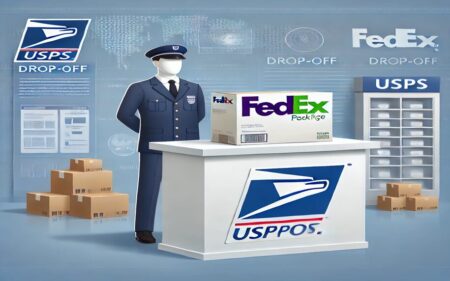Efficient shipping is very much important for businesses and individuals in today’s fast-paced world. When it comes to using the United States Postal Service (USPS), you have two main account options: a USPS Business Account and a Personal USPS Account. But which one is the right fit for you? Let’s figure it out!
The best choice between a USPS Business Account and a Personal Account depends on your specific needs. Business accounts are ideal for high-volume shippers and offer more advanced features, while personal accounts are perfect for occasional shippers who prioritize simplicity and ease of use.
What are USPS Business and Personal Accounts?
Before we delve into the specifics, let’s get a clear picture of what these accounts actually are. A USPS Business Account is designed for companies and organizations that frequently ship packages and mail. It offers a range of features tailored to meet the needs of businesses, from small startups to large corporations.
On the other hand, a Personal USPS Account is geared towards individuals and small-scale shippers who don’t require the advanced features of a business account. It’s a straightforward option for those who send packages or mail on a less frequent basis.
How Do USPS Business and Personal Accounts Differ?
The main differences between these two account types lie in their features, pricing structures, and intended users. Business accounts offer more advanced tools and potential cost savings for high-volume shippers, whereas personal accounts provide simplicity and ease of use for occasional mailers.
| Feature | USPS Business Account | Personal USPS Account |
|---|---|---|
| Intended Users | Businesses, high-volume shippers | Individuals, occasional shippers |
| Shipping Discounts | Eligible for Commercial Base Pricing | Standard retail rates |
| Advanced Features | Yes (e.g., batch shipping, API integration) | Limited |
| Minimum Volume Requirements | May apply | None |
| Address Management | Multiple address book options | Basic address book |
What Are the Key Benefits of a USPS Business Account?
A USPS Business Account comes with an overload of advantages that can significantly boost your shipping efficiency. First and foremost, you’ll have access to Commercial Base Pricing, which offers discounted rates compared to retail prices. This can lead to substantial savings, especially if you’re sending packages in high volumes. In fact, you can save up to 40% off Priority Mail and 18% off First-Class Mail with a business account, which can make a significant difference to your bottom line.
In addition, a business account provides advanced tracking and reporting tools. You can keep tabs on your shipments in real time and generate detailed reports to analyze your shipping patterns and costs. What’s more, you can set up real-time email and SMS alerts to stay informed about your shipments’ status at every step of the journey.
Moreover, business accounts offer the flexibility to manage multiple shipping addresses, which is a godsend if you have various locations or need to ship to a diverse customer base. You’ll also have access to bulk mailing capabilities, making it easier to handle large-scale shipments.
Another super feature is the ability to schedule package pickups via Priority Mail. This can save you valuable time and resources, especially if you’re running a busy operation. Plus, if you’re often on the move, you can take advantage of mail forwarding services to receive your business mail while traveling.
For those who use PayPal, a business account allows for easy integration, streamlining your payment process. And let’s not forget the convenience of automated postage statements and mailing labels, which can significantly reduce the time spent on administrative tasks.
What Advantages Does a Personal USPS Account Offer?
While a business account might seem like the bee’s knees, a Personal USPS Account has its own set of perks that shouldn’t be overlooked. For starters, it’s incredibly user-friendly and perfect for those who don’t need all the bells and whistles of a business account.
One of the standout features of a personal account is the ability to schedule package pickups right from your doorstep. This can save you a ton of time and hassle, especially if you’re not keen on making frequent trips to the post office.
Furthermore, personal accounts offer basic tracking using the receipt number, allowing you to keep an eye on your shipments. And if you’re tech-savvy, you’ll appreciate the ability to purchase postage online with Click-N-Ship, making the whole mailing process a breeze.
But here’s the real kicker: personal accounts give you access to free Informed Delivery. This nifty service lets you preview your incoming mail and packages, giving you a heads-up on what to expect in your mailbox. It’s like having a sneak peek into the postal world!
What Are the Drawbacks of a USPS Business Account?
While a USPS Business Account offers a host of benefits, it’s not without its drawbacks. One of the main hurdles is the potential for minimum volume requirements. Some business accounts may require you to ship a certain number of packages per month to maintain your account status or access certain discounts.
Another point to consider is the learning curve associated with the more advanced features. If you’re not tech-savvy or don’t have the time to invest in learning new systems, you might find the business account overwhelming at first.
Additionally, business accounts may come with monthly or annual fees, depending on the specific plan you choose. While these fees can often be offset by the savings on shipping costs, they’re still an extra expense to factor into your budget.
What Limitations Come with a Personal USPS Account?
Personal USPS Accounts, while straightforward and user-friendly, do have their limitations. Perhaps the most significant drawback is the lack of access to Commercial Base Pricing. This means you’ll be paying retail rates for your shipments, which can add up quickly if you’re sending packages frequently.
Moreover, personal accounts have limited features when it comes to bulk shipping and address management. If you’re sending large volumes of packages or need to manage multiple addresses efficiently, you might find a personal account somewhat restrictive.
Another limitation is the reduced level of customer support compared to business accounts. While USPS does offer support for personal account holders, it may not be as comprehensive or specialized as the support available to business customers.
How Does Shipping Volume Affect Your Choice?
Your shipping volume is a crucial factor in determining which account type is best for you. As a rule of thumb, if you’re shipping more than 50 packages per month, a business account might be more cost-effective due to the discounted rates and bulk shipping capabilities.
| Shipping Volume | Recommended Account Type |
|---|---|
| 0-50 packages/month | Personal Account |
| 50+ packages/month | Business Account |
However, it’s not just about the numbers. You should also consider the consistency of your shipping volume. If your shipping needs fluctuate significantly from month to month, a personal account might offer more flexibility without the pressure of meeting minimum volume requirements.
Here’s the bottom line: Business accounts are designed for high-volume shippers who can take full advantage of the discounted rates. If you’re sending packages frequently, those savings can really add up. On the flip side, if you’re an occasional shipper, a personal account might be more cost-effective, as you won’t be paying for features you don’t need.
What Cost Considerations Should You Keep in Mind?
When it comes to costs, there are several factors to consider. Business accounts often provide access to discounted shipping rates, which can lead to significant savings over time. However, these accounts may come with fees or minimum spending requirements.
Personal accounts, while free to set up, generally don’t offer the same level of discounts. But they do provide flexibility and no ongoing costs, which can be beneficial if your shipping needs are sporadic.
To put it in perspective, let’s look at a hypothetical example:
| Account Type | Monthly Fee | Shipping Rate (1 lb package) | Monthly Volume | Total Monthly Cost |
|---|---|---|---|---|
| Business | $20 | $7 | 100 packages | $720 |
| Personal | $0 | $8 | 100 packages | $800 |
In this scenario, despite the monthly fee, the business account would save you $80 per month. But remember, your actual savings will depend on your specific shipping patterns and the current USPS pricing structure.
What are the main cost differences between a USPS business account and a personal account?
The primary cost difference between USPS business and personal accounts lies in the shipping rates and potential fees. Business accounts offer significant discounts on shipping rates, which can translate to substantial savings for high-volume shippers. For instance, business accounts can save up to 40% off retail prices for Priority Mail and up to 18% for First-Class Mail.
On the flip side, personal accounts usually pay retail rates for shipping services. While these rates are straightforward and don’t come with any account fees, they can be higher than the discounted rates available to business account holders.
It’s worth noting that some business accounts may have monthly or annual fees, depending on the specific plan you choose. These fees can often be offset by savings on shipping costs, but they’re an important factor to consider when calculating your overall shipping expenses.
How do discounted rates for business accounts compare to personal accounts?
The discounted rates for business accounts can offer significant savings compared to personal account rates, especially for frequent shippers. Let’s break it down:
- Priority Mail: Business accounts can save up to 40% off retail rates.
- First-Class Mail: Savings of up to 18% are available for business accounts.
- Priority Mail Express: Discounts are also available, though the percentage varies.
To put this into perspective, let’s look at a practical example:
| Service | Personal Account Rate | Business Account Rate | Savings |
|---|---|---|---|
| Priority Mail (1 lb package) | $7.95 | $6.36 | 20% |
| First-Class Mail (1 oz letter) | $0.58 | $0.48 | 17% |
These savings can add up quickly, especially if you’re shipping multiple packages daily. However, it’s important to remember that the exact discount percentages can vary based on factors like package weight, dimensions, and destination.
How Do Tracking and Reporting Features Compare?
Both account types offer tracking capabilities, but business accounts typically provide more advanced options. With a business account, you can access detailed tracking information, set up automated tracking updates, and even integrate tracking data with your own systems through USPS APIs.
Personal accounts, while more limited, still offer reliable tracking services. You can easily track your packages online or through the USPS mobile app, receiving updates at key points in the delivery process. The main difference is that personal accounts use basic tracking with the receipt number, while business accounts offer more comprehensive tracking options.
When it comes to reporting, business accounts really shine. They offer comprehensive reporting tools that allow you to analyze your shipping patterns, costs, and delivery performance. This data can be invaluable for optimizing your shipping strategy and improving your overall efficiency.
What Additional Services Are Available with Each Account Type?
Both account types offer access to a range of USPS services, but business accounts typically provide more options and flexibility. Here’s a quick comparison:
| Service | Business Account | Personal Account |
|---|---|---|
| Priority Mail Express | ✓ | ✓ |
| Priority Mail | ✓ | ✓ |
| First-Class Mail | ✓ | ✓ |
| Media Mail | ✓ | ✓ |
| Bulk Mail Services | ✓ | Limited |
| International Shipping | ✓ | ✓ |
| API Integration | ✓ | ✗ |
| Customized Forms | ✓ | Limited |
As you can see, while both account types cover the basics, business accounts offer more specialized services that can be particularly useful for high-volume or complex shipping needs.
How User-Friendly Are Business vs. Personal Accounts?
When it comes to user-friendliness, personal accounts generally have the edge. They’re designed with simplicity in mind, making them easy to navigate even for those who aren’t tech-savvy. The interface is straightforward, allowing you to quickly create shipping labels, schedule pickups, and track packages.
Business accounts, while more feature-rich, can be more complex to use. They often require some initial setup and may have a steeper learning curve. However, once you’re familiar with the system, business accounts offer powerful tools that can significantly streamline your shipping process.
It’s worth noting that USPS provides resources and tutorials for both account types to help users make the most of their features. You can find these resources on the USPS website.
What Customer Support Options Are Available?
Customer support is an essential consideration when choosing between account types. Business accounts typically offer more comprehensive support options, including dedicated account managers for high-volume shippers and specialized technical support for users of advanced features like API integration.
Personal accounts, while not offering the same level of specialized support, still provide reliable customer service. You can get help through the USPS website, by phone, or by visiting your local post office.
Here’s a quick comparison of support options:
| Support Option | Business Account | Personal Account |
|---|---|---|
| Phone Support | ✓ | ✓ |
| Email Support | ✓ | ✓ |
| Live Chat | ✓ | ✓ |
| Dedicated Account Manager | ✓ (for high-volume shippers) | ✗ |
| In-Person Support at Post Offices | ✓ | ✓ |
| Technical Support for Advanced Features | ✓ | Limited |
How Do Small Businesses Benefit from Each Account Type?
For small businesses, the choice between a business and a personal account can be a bit tricky. On one hand, a business account offers potential cost savings and advanced features that can help streamline operations. This can be extremely beneficial as your business grows and your shipping needs become more complex.
On the other hand, a personal account might be sufficient if you’re just starting out and your shipping volume is low. It offers simplicity and flexibility without the potential commitments of a business account.
Here’s a tip: Many small businesses start with a personal account and transition to a business account as their shipping needs grow. This approach allows you to familiarize yourself with USPS services before committing to a more advanced account type.
Can I use a USPS business account for personal shipping needs?
Absolutely! While USPS business accounts are designed with commercial shippers in mind, there’s no rule against using them for personal shipping needs. In fact, if you’re a frequent shipper, even for personal items, you might find the discounted rates and advanced features of a business account beneficial.
However, keep in mind that business accounts may have minimum volume requirements or fees that might not be cost-effective if you’re only shipping occasionally. It’s all about finding the right balance for your specific needs.
Here’s a pro tip: If you run a small business from home or have a side hustle that requires frequent shipping, a business account could be a great option. It allows you to take advantage of discounted rates for both your business and personal shipping needs.
What are the steps to switch from a USPS personal account to a business account?
If you’ve been using a personal account and find that your shipping needs have outgrown its capabilities, switching to a business account is a straightforward process. Here’s a step-by-step guide:
- Visit the USPS website: Go to the USPS Business Customer Gateway.
- Create a business account: Click on “Register for a Business Account” and follow the prompts.
- Verify your business: You’ll need to provide some basic information about your business, including your Tax ID number.
- Choose your services: Select the USPS business tools and services you want to use.
- Set up payment method: Decide how you’ll pay for postage (options include postage meter, permit imprint, or USPS Corporate Account).
- Complete the registration: Review and accept the terms and conditions.
- Await approval: USPS will review your application and may contact you for additional information.
- Start shipping: Once approved, you can start using your new business account.
Remember, you don’t need to close your personal account when you open a business account. Many users find it helpful to maintain both, using the business account for high-volume shipping and the personal account for occasional mailings.
Key Takeaways: USPS Business Account Vs Personal Account
- Business accounts offer significant discounts (up to 40% on Priority Mail, 18% on First-Class Mail) compared to personal accounts’ retail rates.
- Business accounts provide advanced features like bulk mailing and API integration, while personal accounts offer basic services suitable for occasional shippers.
- Shipping volume is a key factor: business accounts are typically more cost-effective for those shipping over 50 packages per month.
- Business accounts may have fees or minimum requirements, whereas personal accounts are free but lack discounts.
- Business accounts offer more comprehensive tracking and reporting tools, including real-time alerts.
- Personal accounts are generally more user-friendly, while business accounts have a steeper learning curve but provide powerful shipping management tools.
- The choice between accounts depends on shipping volume, budget, desired features, and anticipated growth in shipping needs.
- Users can transition from a personal to a business account as their shipping needs increase, and it’s possible to maintain both types for different purposes.











Leave a Reply